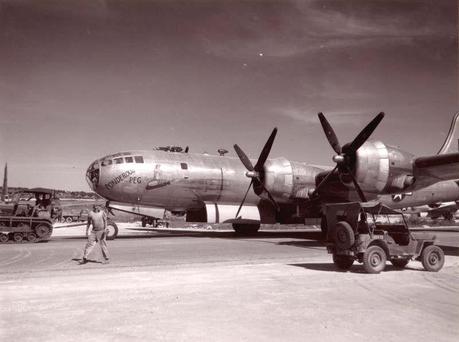Commentary about the B-29 by Ed Hart:
The B-29 was an inflection point in the history of aviation technology, war fighting…and program management. It certainly rivaled the A-Bomb program, and the fact that the two programs came together to end the war is – I think – instructive to all of us. I recently saw a program on the B-29 on History Channel and thought that I would reach out to this site to see if any “old timers” are out there who might be able to give accuracy to some impressions that I have carried for 50 years. I hold memories of stories told to me by a wonderful vet I knew as a youngster growing up in Ohio. Quentin Walker, of Lancaster, Ohio told me that he had served in the 509th Composite Wing as a flight engineer, having washed out as a pilot. He blew out a knee in a football game when his squadron went from Wendover to California for a football game. Because of that, he did not go to Tinian. Some of the stories he told were hard to believe, but I thought it would be fun to bounce them off of this group of readers to see what might be correct….so here goes:
Quent’s crew had flown out to Kansas (?) to pick up their Silverplate aircraft, arriving at the factory after dark. At that stage, he had never seen a B-29 in person, but when he saw it, he said it solidified his view that there simply was not enough wing to carry the aircraft! He said it looked like a shiny spacecraft to him, shimmering in the factory lights. Having trained in lesser aircraft, however, he said that once he sat in the engineer’s position, in a nice soft seat, he thought this would be an OK way to go to war! He said the rolled it out next day and flew to Wendover (I think).

B-29 Photo Gallery
He said that they when not carrying a payload, the aircraft could easily top 400 mph true airspeed. Possible??
He said that his crew got him some wire to replicate the War Emergency Power wire across the throttle quadrant, so they could “goose” the aircraft for fun. (Later, they would complain that the engines needed work, and get an overhaul!) During training, he described how they would practice taking on P-51s at high altitude. He said that by waiting until the P-51 was committed to its curving attack profile from behind, they would goose the plane with WEP and turn slight inside, causing the P-51 to stall out as he tightened his turn. Possible??
He said that taking each of the aircraft down into the Grand Canyon was a right of passage for the all crews in the group. His group did it. Heard about that? He said that Tibbetts threatened them by saying that the government was going to string cables across the canyon to discourage that kind of thing. ??
Finally, he told me that one day they decided to see how high their B-29s would fly, and with no payload he said they touched 50,000 feet. Possible?? I thought that might be a bit crazy, but I had another friend – younger than Quent – who had been a crew chief on an RB-36H. He flew many of the missions as part of the crew, and said they regularly topped 50,000 ft, in fact he said they topped 55,000 ft when lightly loaded. Yes, a very different wing, but I think I have heard others say that B-29s could “get up there.”
Those conversations left me with a strong view that the B-29 was pretty amazing. For sure, we can say that the B-29 was the point through which ALL aircraft designs passed, for the US, Europe and the Soviets, as well.
Feel free to write directly if you have supporting or conflicting data on these unique Silverplate aircraft.
Thanks,
Ed Hart (ed.hart at comcast.net)
Thanks Ed! If you have a story or commentary about WWII you would like to share with our readers see the about us section of the website and send us an email with your topic.
